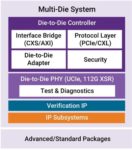You are currently viewing SemiWiki as a guest which gives you limited access to the site. To view blog comments and experience other SemiWiki features you must be a registered member. Registration is fast, simple, and absolutely free so please,
join our community today!
Dan is joined by a panel of experts to discuss chiplets and 2.5/3D design. The panelists are: Saif Alam – Vice President of Engineering at Movellus Inc., Tony Mastroianni Siemens EDA- Advanced Packaging Solutions Director and Craig Bishop – CTO Deca Technologies.
In this spirited and informative discussion the … Read More
Semiconductor industry is going through an unprecedented technological revolution with AI/ML, GPU, RISC-V, chiplets, automotive and 5G driving the hardware design innovation. The race to deliver high performance, optimizing power and area (PPA), while ensuring safety and security is truly on. It has never been a more exciting… Read More
Harry Peterson is a mixed-signal chip designer with a BS in Physics from Caltech. He managed IC design groups within Fairchild, Kodak, Philips, Northern Telecom, Toshiba and Pixelworks. During sabbaticals he helped fly experiments on NASA’s orbiting satellite observatory (OSO-8) and build telescopes in the Canary… Read More
-SEMICON well attended but bouncing along the biz bottom
-Recovery seems at least a year away with memory even more
-AI creates hope but not impactful- Disconnect tween stocks & reality
-AMAT me too platform- Back end benefits from chiplets
SEMICON busy but subdued
SEMICON is certainly back to pre-covid levels or perhaps better.… Read More
Chances are anyone who attended the CEO Outlook will say it was an engaging, entertaining and enlightening view of the chip design space, though CEO Outlook may be a misnomer as four of the seven panelists had C-Suite titles other than CEO.
Regardless, the collective view was optimistic, though caution prevailed as the economic… Read More
Many credible market analysis firms are predicting the semiconductor market to reach the trillion dollar mark over the next six years or so. Just compare this to the more than six decades it took for the market to cross the $500 billion mark. The projected growth rate is incredible indeed and is driven by fast growing market segments… Read More
Chiplets continue to be a hot topic on SemiWiki, conferences, white papers, webinars and one of the most active chiplet enabling vendors we work with is Synopsys. Synopsys is the #1 EDA and #1 IP company so that makes complete sense.
As you may have read, I moderated a panel on Chiplets at the last SNUG which we continue to write about.
…
Read More
In the 3D-IC (Three-dimensional integrated circuit) chip design method, chiplets or wafers are stacked vertically on top of each other and are connected using Through Silicon Vias (TSVs) or hybrid bonding.
The 2.5D-IC design method places multiple chiplets alongside each other on a silicon interposer. Microbumps and interconnect… Read More
For decades now I’ve watched the incredible growth of SoCs in terms of die size, transistor count, frequency and complexity. Instead of placing all of the system complexity into a single, monolithic chip, there are now compelling reasons to use a multi-chip approach, like when the maximum die size limit is reached, or it’s… Read More
Chiplet-based System-on-Chips (SoCs) are becoming increasingly popular in the semiconductor industry due to their potential to improve design efficiency, increase performance, and reduce costs. While chiplets are seen as a way to reduce the cost of innovation, they introduce a lot of challenges too. Packaging, interconnect… Read More







